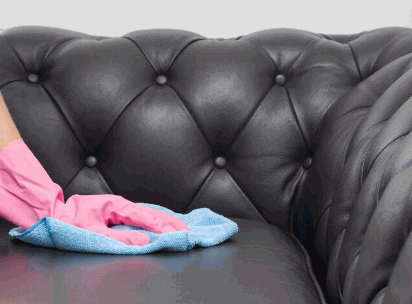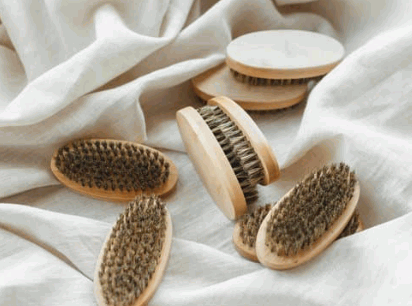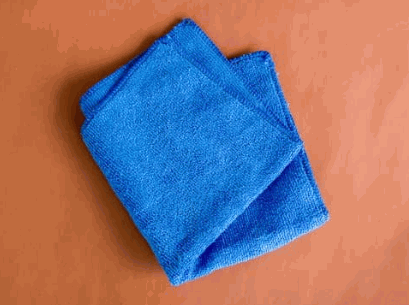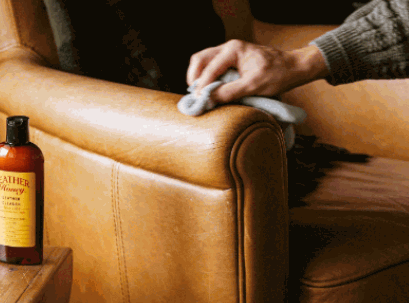Is your leather sofa looking a bit worse for wear? It may be time for a deep clean to restore its beauty and prolong its lifespan.
In this article, we will discuss why it is important to deep clean a leather sofa, the tools and supplies you will need for the job, and provide a step-by-step guide on how to effectively clean your sofa.
We will also share some tips on how to maintain a clean and healthy leather sofa.
So, grab your soft-bristled brush and leather cleaner, and let’s get started!

Why Is It Important To Deep Clean A Leather Sofa?
Regular deep cleaning of a leather sofa is crucial to maintain its quality, longevity, and appearance. Over time, dust, dirt, and oils can accumulate on the surface and within the pores of the leather, leading to discoloration, stiffness, and potential damage.
These particles not only affect the visual appeal of the sofa but can also degrade the leather material itself if left unattended. Without proper cleaning, the oils from skin contact, dust, and dirt can seep into the pores and crevices, causing irreparable harm over time. The accumulation of such debris can result in a rough texture, making the sofa uncomfortable to sit on.
Explore: Is It Safe To Steam Clean Leather Furniture

What Tools And Supplies Do You Need For Deep Cleaning?
Effective deep cleaning of a leather sofa requires specific tools and supplies to ensure thorough and gentle cleaning without causing damage to the material. Essential items include a soft-bristled brush, microfiber cloths, specialized leather cleaner, and quality leather conditioner.
Microfiber cloths are ideal for wiping down the leather surface without leaving behind lint or scratches, ensuring a pristine finish. A soft-bristled brush is crucial for reaching into creases and seams to lift dirt and grime gently. When selecting a leather cleaner, opt for a product formulated specifically for leather to avoid harsh chemicals that could strip away natural oils.
To maintain the suppleness and luster of your leather sofa, regular application of a high-quality leather conditioner is essential. Conditioning helps prevent drying, cracking, and fading, prolonging the life of your furniture.
Soft-Bristled Brush
A soft-bristled brush is a versatile tool essential for loosening dirt and debris from the surface of a leather sofa without causing scratches or damage. When paired with a suitable leather cleaning product, the brush can effectively remove embedded particles and prepare the leather for conditioning.
Using a soft-bristled brush is particularly beneficial as it ensures a gentle approach to cleaning, safeguarding the leather’s delicate surface. The soft bristles help in dislodging dirt and grime without harsh abrasion, maintaining the sofa’s integrity.
- To utilize the brush properly, start by applying a small amount of leather cleaning solution onto a clean, dry cloth.
- Then, gently scrub the surface in circular motions with the soft-bristled brush, focusing on areas with visible dirt or stains.

Microfiber Cloths
Microfiber cloths are ideal for routine leather cleaning and conditioning due to their soft and non-abrasive nature. When used with a quality leather conditioner, microfiber cloths help to apply the product evenly, allowing the leather to absorb the conditioning agents effectively and maintain its suppleness.

Leather Cleaner
A specialized leather cleaner is essential for removing stains, dirt, and grime from a leather sofa without compromising its finish. Formulated with ingredients like distilled water and white vinegar, leather cleaners effectively lift impurities from the surface while maintaining the natural texture and color of the leather.
When dealing with tough stains or persistent dirt on your beloved leather furniture, a dedicated leather cleaner becomes your best ally. These cleaners are designed to penetrate deep into the pores of the leather, breaking down stubborn marks without causing any damage.
One of the key benefits of using distilled water in leather cleaners is its purity, ensuring that no harmful impurities or minerals are left behind on the leather surface. Similarly, white vinegar plays a crucial role in these cleaners by acting as a natural disinfectant and deodorizer, leaving your leather furniture not only clean but also fresh.

Leather Conditioner
Applying a high-quality leather conditioner is essential to replenish moisture, restore suppleness, and protect the leather sofa from drying out or cracking. Ingredients like baking soda and rubbing alcohol in leather conditioners help nourish the leather fibers, keeping them soft and resilient over time.
Leather, being a natural material, requires regular care to maintain its luxurious look and feel. Using a leather conditioner not only prevents the leather from becoming brittle but also helps in retaining its natural oils and color. The combination of baking soda and rubbing alcohol in these products aids in removing stubborn stains, enhancing the durability of the leather, and providing a protective layer against spills and wear.

Step-By-Step Guide For Deep Cleaning A Leather Sofa
Following a systematic step-by-step process is essential for deep cleaning a leather sofa effectively while preserving its integrity and beauty. The process typically involves removing loose dirt, testing a small area with a leather cleaner, applying the cleaner, wiping it off, and finally conditioning the leather to maintain its luster.
Begin the deep cleaning process by using a soft-bristled brush or vacuum attachment to gently remove surface dust and debris from the leather sofa. This initial step is crucial as it prevents dirt from becoming embedded in the leather during the cleaning process.
Next, choose a high-quality leather cleaner that is suitable for the type of leather on your sofa. Before applying it, always perform a patch test in an inconspicuous area to ensure compatibility and avoid any potential damage.
Step 1: Remove Loose Dirt And Dust
Begin the deep cleaning process by gently removing loose dirt and dust particles from the surface of the leather sofa using a soft-bristled brush or microfiber cloth. This initial step is crucial for regular maintenance and prevents debris from settling into the pores of the leather, maintaining its pristine condition.
Regular cleaning not only enhances the appearance of leather items but also prolongs their lifespan. By eliminating dirt promptly, you can prevent scratches and wear caused by abrasive particles rubbing against the leather.
Routine cleaning ensures that the leather retains its natural oils and flexibility, preventing it from drying out and cracking over time. It is advisable to incorporate a gentle cleaning routine into your maintenance schedule to safeguard the beauty and integrity of your cherished leather pieces.
Step 2: Prepare The Leather Cleaner
Before applying the leather cleaner to the sofa, ensure that it is properly diluted or mixed according to the manufacturer’s instructions. Using suitable leather cleaning products designed for natural leather ensures effective stain removal and gentle cleaning without causing damage to the material.
Preparing the leather cleaner correctly is essential to maintain the quality and longevity of your furniture. Improper dilution can lead to streaks, discoloration, or even damage to the leather. By following the manufacturer’s guidelines, you can ensure that the cleaner works effectively while protecting the natural texture of the leather. Consistency in application and using the right products not only removes dirt and stains but also nourishes and keeps the leather supple. It’s like giving your sofa a spa treatment to preserve its beauty for years to come.
Step 3: Test The Cleaner On A Small Area
Before applying the leather cleaner to the entire sofa, perform a patch test on a small inconspicuous area using a mixture of the cleaner, white vinegar, or a small amount of leather cream. This test helps to ensure compatibility with the leather surface and avoids potential damage or discoloration.
By conducting a patch test, you can assess how the leather reacts to the ingredients, ensuring that the cleaner does not cause any unwanted effects on the overall appearance or texture. It is crucial to remember that certain cleansers may contain chemicals or agents that could harm the leather if not properly tested beforehand. This simple step can save you from costly repairs or irreversible damage to your beloved leather furniture.

Step 4: Apply The Cleaner To The Sofa
Using a clean microfiber cloth, apply the diluted leather cleaner solution to the entire surface of the sofa, working in gentle circular motions. The cleaner, often containing rubbing alcohol for effective cleaning, helps to lift stains and dirt while maintaining the natural beauty of the leather.
Before applying the cleaner, it is essential to test it on a small, inconspicuous area of the sofa to ensure compatibility with the leather. Once confirmed, proceed to apply the solution to the rest of the sofa, focusing on one section at a time to ensure thorough cleaning. Remember to apply only a small amount of cleaner to avoid oversaturation.
When working in circular motions, apply gentle pressure to help the cleaning solution penetrate and lift dirt effectively. Avoid harsh scrubbing, as this can potentially damage the leather surface. By using rubbing alcohol as part of the cleaner, you can achieve a deeper clean without compromising the leather’s integrity.

Step 5: Wipe Off The Cleaner
After allowing the leather cleaner to sit for the recommended time, gently wipe off the excess solution using a clean microfiber cloth.
This step is crucial as it helps to get rid of any lingering grime and dirt that the cleaner has loosened on the surface. The gentle wiping motion ensures that the leather is not damaged during the cleaning process. Baking soda-infused cleaners are particularly effective in deep cleaning, thanks to the natural abrasive properties of baking soda that help in removing tough stains.
Before moving on to the leather conditioning stage, it is essential to ensure that all traces of the cleaner are completely removed. Residues left behind can interfere with the conditioning product’s absorption and effectiveness.

Step 6: Apply Leather Conditioner
Finish the deep cleaning process by applying a generous amount of leather conditioner, such as Leather Honey, to the entire sofa surface using a fresh microfiber cloth. Massage the conditioner into the leather in circular motions to ensure even coverage and deep penetration, restoring moisture and suppleness.
Regular conditioning with a quality product is crucial for keeping your leather furniture in top condition. The massaging action not only helps the conditioner to seep into the leather pores effectively but also enhances its flexibility and durability.
By nourishing the leather, you not only maintain its softness and prevent drying out but also protect it from cracking and fading due to exposure to sunlight and wear.

Tips For Maintaining A Clean And Healthy Leather Sofa
To maintain a clean and healthy leather sofa, follow these essential tips: promptly wipe up spills to prevent staining, vacuum the sofa regularly to remove dust and debris, protect the leather from direct sunlight to avoid fading and drying, use a leather protector to safeguard against stains and spills, and avoid harsh cleaning products that can damage the surface.
One of the most critical aspects of leather sofa maintenance is to address spills promptly to prevent any lasting damage. For liquid spills, gently blot the affected area with a clean cloth to absorb as much of the liquid as possible without rubbing it in. Avoid using harsh cleaners or excessive water, as these can penetrate the leather and cause further damage. It’s also recommended to regularly vacuum the sofa using a soft brush attachment to prevent dust and debris from settling into the leather pores.
Wipe Up Spills Immediately
Immediate action is crucial when spills occur on a leather sofa to prevent liquids from seeping into the material and causing permanent stains. Use a clean cloth to gently blot the spill and avoid rubbing, followed by a gentle cleaning with a leather conditioner to restore any affected areas.
Leather sofas are not only luxurious but also require special care to maintain their pristine appearance. By promptly addressing spills, you not only prevent unsightly stains but also protect the integrity of the leather. Using a quality leather conditioner ensures that the leather remains supple and resistant to future spills. Regular conditioning not only nourishes the leather but also helps maintain the sofa’s natural shine and texture.

Vacuum Regularly
Regular vacuuming of a leather sofa helps remove dust, dirt, and debris that can accumulate on the surface and in crevices.
By incorporating this simple maintenance routine into your cleaning regimen, you can prolong the life of your leather sofa and keep it looking pristine for years to come. Baking soda is a versatile and cost-effective solution for tackling odors, making it an ideal addition to your cleaning arsenal. Its natural deodorizing properties can effectively neutralize smells without leaving behind any harsh chemical residues, ensuring a safe and pleasant environment for you and your family.

Keep Away From Direct Sunlight
Direct sunlight exposure can cause leather sofas to fade, dry out, and deteriorate over time due to UV radiation. To protect the leather’s finish and color, position the sofa away from direct sunlight or use curtains and blinds to shield it. If needed, a gentle cleaning with rubbing alcohol can help restore the leather’s luster.
Leather, being a natural material, is sensitive to prolonged exposure to sunlight, which can lead to discoloration and cracking. Shielding the sofa from direct sunlight not only helps maintain its aesthetics but also prolongs its longevity. Moisturizing leather regularly with a specialized conditioner can prevent it from drying out and cracking. Placing the sofa in a well-ventilated area can also aid in preserving its quality. Remember to perform a patch test before using rubbing alcohol for cleaning to ensure it doesn’t cause any damage.
Use A Leather Protector
Applying a leather protector shields the sofa from spills, stains, and moisture, extending its lifespan and maintaining its appearance. Opt for a quality protector that offers water and stain resistance, and occasionally clean the sofa with a mixture of white vinegar and water to refresh and protect the leather surface.
By creating a barrier between the leather and external elements, a protector acts as a shield, preventing liquids from seeping into the material. This not only helps in avoiding immediate damage but also ensures easier cleaning later on.
Regularly treating your sofa with a protector not only safeguards against accidental spills but also protects it from natural wear and tear, such as fading due to exposure to sunlight. The simple act of using a protector can significantly extend the life of your beloved piece of furniture.

Avoid Harsh Cleaning Products
Harsh cleaning products containing abrasive chemicals or alcohol should be avoided when cleaning leather furniture to prevent damage, discoloration, or drying out of the material. Opt for mild and natural cleaning solutions suitable for leather items to ensure gentle yet effective cleaning without compromising the leather’s integrity.
Choosing the right cleaning products for your leather furniture goes a long way in maintaining its beauty and longevity. It’s crucial to consider the potential risks posed by harsh chemicals and alcohol-based cleaners, as these can strip the leather of its natural oils, leading to cracks and color changes over time. By selecting mild and natural solutions, you not only safeguard the material but also ensure a safer environment for your household.
Leather, being a delicate material, requires a gentle touch for cleaning and conditioning. By incorporating gentle cleaning practices and using products specifically designed for leather care, you can keep your furniture looking rich and luxurious for years to come.
 My name is Stacey Reid the senior author at Art Syndicate. I enjoy everything homely and everyday I am amazed at the creativity that I find on the internet to write about and the items that I find to sell to our visitors. I cannot however find everything out there as it is very time consuming so please come and take the time to tell us about something new if you think our visitors would like it.
My name is Stacey Reid the senior author at Art Syndicate. I enjoy everything homely and everyday I am amazed at the creativity that I find on the internet to write about and the items that I find to sell to our visitors. I cannot however find everything out there as it is very time consuming so please come and take the time to tell us about something new if you think our visitors would like it.